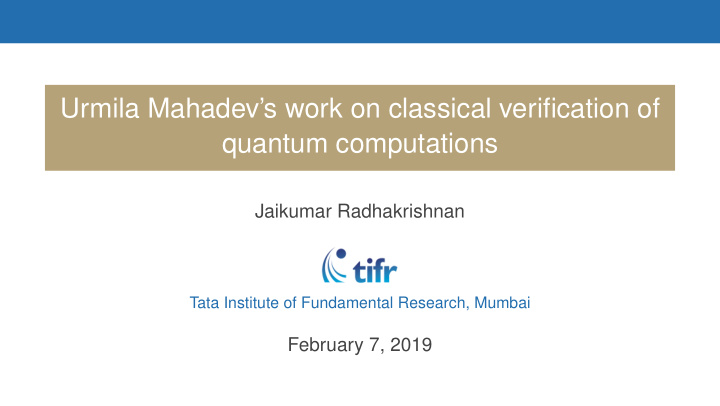



Urmila Mahadev’s work on classical verification of quantum computations Jaikumar Radhakrishnan Tata Institute of Fundamental Research, Mumbai February 7, 2019
Urmila Mahadev, PhD student, UC Berkeley Urmila Mahadev: Classical Verification of Quantum Computations. FOCS 2018: 259-267. (Best paper and best student paper!) Urmila Mahadev: Classical Verification of Quantum Computations. https://arxiv.org/abs/1804.01082 Urmila Mahadev: Classical Verification of Quantum Computations. Talk at IAS: https://www.youtube.com/watch?v=kql5dSywvy0
Classical computation Inputs and outputs: { 0 , 1 } n Gates: ANDs, ORs and NOTs The computation is efficient if it uses only a polynomial number of basic gates. Randomized gates: R , generates a uniformly random bit Allow errors but would like the output to be correct with high probability
Verifying classical computation Suppose some computing device claims to solve a large Hamilton cycle instance. We do not have the means to solve and verify this claim ourselves. But we can still verify the claim efficiently. The problem is in NP . So, we can reduce it to a 3-SAT instance and ask the solver to provide us a satisfying assignment.
Quantum computation Similar to randomized computation, but it is reversible. The Hadamard gate is like a random coin toss, but the input influences the sign of the amplitude. It is usually written as a matrix. H = 1 � 1 � 1 √ 1 − 1 2 H is its own inverse. In general, the state of an n -qubit system is an amplitude vector of 2 n entries. At each step, when a gate is applied, the change in the state vector is determined by a unitary matrix. We will need (for today) two special one-qubit gates: � 0 � � 1 � 1 0 X = and Z = 1 0 0 − 1
The power of quantum We know of some problems that one can solve more easily on a quantum computer. A number can be factored in polynomial time on a quantum algorithm. (Shor 1994). Quantum cryptography can do things that classical cryptography can’t. But we do not yet have even a decent quantum computer . . .
What if . . . ? . . . quantum computers of moderate size perform certain tasks more efficiently than classical computers? Noisy Intermediate-Scale Quantum Technology Quantum supremacy Can we verify that these quantum computers are indeed solving the problem faster? Note the problem they solve may not be in NP .
Urmila Mahadev’s work Theorem Assuming the existence of an extended trapdoor claw-free family, all decision problems that can be efficiently computed in quantum polynomial time can be verified by an efficient classical machine by interacting with the quantum machine. A family of extended trapdoor claw-free function can be constructed under the assumption that the problem of learning with errors is hard for quantum computers.
Learning with errors Two special distributions on matrix-vector pairs. ( A , As + e (mod q )) where A is a random n × m matrix and s is a random m -dimensional vector and e is drawn from a special trucated Gaussian distribution on m -dimensional vectors. ( A , u ) , where u is uniformly chosen vector. The two distributions are far apart statistically. Assumption: No quantum polynomial-time procedure can distinguish these distributions with even negligible advantage. Based on the hardness of the LWE problem, one can construct a family of extended trapdoor claw-free functions.
Trapdoor functions Trapdoor claw-free functions A family F = { f k , b : X → Y} such that the functions f k , 0 and f k , 1 are injective and their images are identical. It is computationally hard given k to find a string d � = 0, the bit d · ( x 0 ⊕ x 1 ) , where f 0 ( x 0 ) = f 1 ( x 1 ) . The trapdoor t k allows one to invert the function. Trapdoor injective functions A family G = { g k , b : X → Y} , such that the images of g k , 0 and g k , 1 are disjoint. The trapdoor t k helps invert the function. The keys k for claw-free and injective functions are computationally indistinguishable.
Trapdoor functions aided measurement Prover Has a state | φ � = α 0 | 0 � + α 1 | 1 � . Verifier Sends a key k (for either a claw-free function or an injective function), but holds on to the trapdoor t k Prover Would like to help the verfier make a measurement of | φ � . Prepares | φ � � x | x � . Appends the bit in the first register to the key and computes the function of x , and sends the result y to the Verifier. Verfier The Verifier either asks for a standard basis measurement or a Hadamard measurement of all of Prover’s registers. Prover Sends the bits to the Verifier. Verifier Decodes the result.
The verifier cannon cheat If the Prover does pass the Verifier’s checks with reasonable probability, then the bits the Verfier receives do correspond to measurement of an underlying quantum state. These measurement outcomes can be used by the Verifier to check if the quantum computer’s claims are justified.
Thank you!
Recommend
More recommend